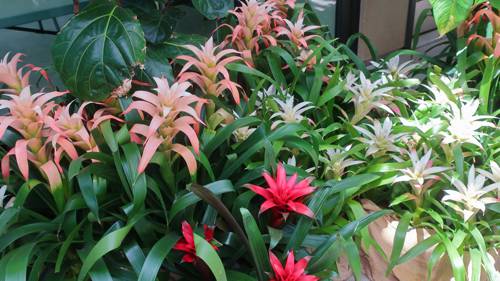
FAQ About Indoor Plant Bromeliad Care

What kind of light do indoor bromeliads need?
Indoor bromeliads thrive best in bright, indirect light. Direct sunlight can scorch their leaves, while too little light will slow their growth and cause the colors of the leaves to wash out. A location near a window that receives filtered sunlight is ideal for maintaining healthy bromeliads indoors.

How often should I water my bromeliad plant?
Bromeliads require less frequent watering than many other plants. Water should be added to the central cup of the plant, keeping it filled about one-third to half full. Generally, watering once every week or two should be sufficient, but frequency may vary depending on the humidity and temperature of your home.

What humidity levels do bromeliads prefer?
Bromeliads prefer a humidity level of around 50% or higher. If your home is particularly dry, consider using a humidity tray or a humidifier to increase the moisture in the air around the plant. Regular misting can also help maintain adequate humidity levels.

Can bromeliads be grown under artificial light?
Yes, bromeliads can be successfully grown under artificial light. Fluorescent lights or LED grow lights that provide full-spectrum light work well. Place the lights above the bromeliads, and ensure they are on for about 12 to 16 hours per day to mimic a natural day-night cycle.

What type of soil is best for bromeliads?
Bromeliads require a well-draining soil mixture. A blend of orchid bark, perlite, and peat moss is often recommended to ensure the roots do not become waterlogged. The soil should allow for good air circulation around the roots.

Do bromeliads need fertilizing?
While bromeliads do not require heavy fertilization, a diluted liquid fertilizer can be applied every 2 to 4 weeks during the growing season. Be sure to use a fertilizer with a balanced N-P-K ratio and avoid over-fertilization, as bromeliads are sensitive to high nutrient levels.

How do I propagate bromeliads?
Bromeliads can be propagated through offsets known as "pups," which grow at the base of the plant. Once a pup reaches about one-third the size of the parent plant, it can be removed and potted separately. Allow the cut to dry for a day or two before planting the pup in fresh soil.

What should I do if my bromeliad's leaves start to turn brown?
Brown leaves on bromeliads can result from a number of factors, including underwatering, low humidity, or nutrient deficiencies. Evaluate the plant's water and humidity needs and adjust care accordingly. Removing dead or dying leaves can also encourage healthier growth.

How do I care for a bromeliad once it has finished flowering?
After a bromeliad finishes flowering, the central flower will die off, but the plant itself can continue to thrive. Remove the spent flower spike to improve the plant's appearance and care for the bromeliad as you normally would. New pups will often form, which can be propagated to grow new plants.

What temperature range is ideal for bromeliads?
Bromeliads thrive in temperatures between 60-80°F (16-27°C). Protect them from cold drafts and temperatures below 40°F (4°C), which can lead to damage or death. Maintaining stable temperatures will support healthy growth and flowering.

Is it necessary to trim bromeliad roots?
Bromeliads generally do not require root trimming. However, if you are repotting and notice any dead or rotted roots, these should be trimmed away to prevent any potential infections or issues with the plant's growth.

Can I use tap water for my bromeliad?
It's best to use rainwater, distilled water, or water that's been left to sit out overnight for bromeliads, as tap water often contains chlorine and other chemicals that can harm the plant. If tap water is your only option, consider using a filter to remove impurities.

How do I prevent pests in bromeliads?
To prevent pests such as aphids or mealybugs, keep the area around your bromeliad clean and regularly inspect the plant for signs of infestation. If pests are detected, a gentle insecticidal soap or neem oil can be used to treat the plant.

Why is my bromeliad not blooming?
If a bromeliad is not blooming, it may be due to insufficient light, improper temperatures, or a lack of maturity, as bromeliads typically bloom only once when they are mature. Ensuring optimal light and temperature and exercising patience can encourage blooming.

Can bromeliads improve indoor air quality?
Yes, like many indoor plants, bromeliads can help improve air quality by absorbing pollutants and releasing oxygen. They efficiently help to purify the air and create a healthier indoor environment.

What are common diseases that affect bromeliads?
Common diseases in bromeliads include root rot, which is caused by overwatering and poor drainage, and leaf spot, a fungal or bacterial infection. Ensuring proper care and maintenance can prevent these diseases. Remove affected parts and improve care conditions to deal with infections.

How long do bromeliads live indoors?
A bromeliad plant can live for several years indoors, typically ranging from 2 to 5 years. After blooming, the mother plant will gradually die, but new pups can be propagated to continue the bromeliad's lifecycle.

Do bromeliads require special pots?
Bromeliads do not necessarily require special pots, but choosing a pot with good drainage is important. Terra cotta pots or plastic pots with drainage holes are excellent choices to ensure excess water can escape easily.

What are the best bromeliad varieties for indoor care?
Some of the best bromeliad varieties for indoor care include Aechmea, Guzmania, and Neoregelia. These types are known for their vibrant colors and adaptability to indoor conditions.

How do I clean dust from bromeliad leaves?
To clean dust from bromeliad leaves, gently wipe them with a damp cloth. This will help maintain their ability to photosynthesize efficiently and keep them looking their best. Avoid using detergents or soaps, as these can harm the leaves.
